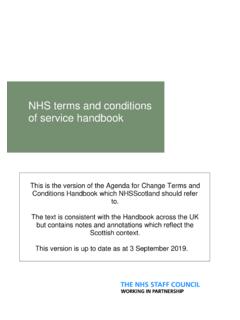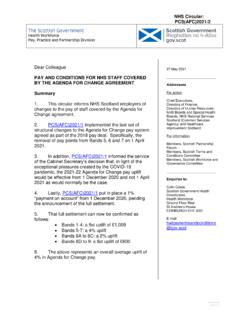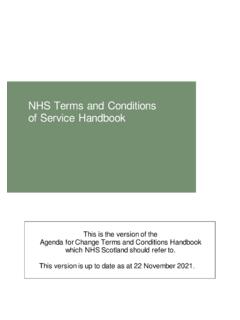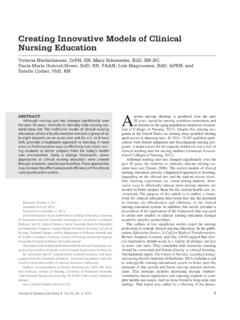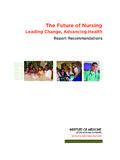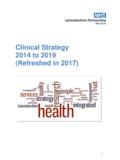Transcription of The NHS Knowledge and Skills Framework - a short guide …
1 January 2006 NHSE mployersA part of the NHS Confederation working on behalf of the The NHS Knowledge and SkillsFramework a short guide toKSF dimensions21 The NHS Knowledge and Skills Framework (NHS KSF) and the development review process, Department of Health,October 2004, available from Full guidance for staff groups is available online at easy-to-use, short guide to the NHS Knowledge and Skills Framework (KSF) is a briefsummary of the guidance contained in the KSF handbook1and guidance for specific guide is designed as a crib sheet to be used alongside the KSF handbook. It is notintended to replace the KSF handbook and should not be used as a sole source of reference in designing KSF post NHS Knowledge and Skills Framework a short guide to KSF dimensions3 Core dimensions4 Specific dimensions8 Guidance on using the health and wellbeing dimensions9 Guidance on using the estates and facilities dimensions19 Guidance on using the information and Knowledge dimensions19 Guidance on using the general dimensions20 Contents4 Core dimensionsEvery KSF outline must contain the core dimensions so the discussion is about agreeing thecorrect level for the post; but remember: think about the aspects of the post that fit into the core dimensions, ratherthan choosing too many specific 1 CommunicationThis dimension underpins all of the other dimensions in the KSF, since communication is a keyaspect of all jobs in the : It covers all forms of communication, including listening.
2 Breaking bad news is not confined to clinical situations think about redundancy, nothaving paid enough tax, hospital 2 Personal and people developmentAll NHS staff need to develop themselves in order for services to continue to meet the needs ofpatients/clients and the : Personal development covers a very wide range of activities during both on-goingwork and learning and development on one s own, for example in-service training, jobshadowing, secondments, acting up , e-learning and distance learning. It does notmean having to attend courses as the sole means of development. Maintaining existing Skills and developing new ones to keep up to date with evidence-based practice is covered here, as is critically appraising new and changing theoreticalmodels, policies and legislation relating to the post. This should be kept in mind whenconsidering if IK3 Knowledge and information resources or G2 Development andinnovation are appropriate specific dimensions to choose.
3 Personal development also covers learning from developing others, so having studentson placement fits in here. This dimension is different from dimension G1 Learning and development, whichfocuses on more formal approaches to learning and development (a clinical tutor whohas students on placement and also teaches on the university course may have G1 inaddition to Core 2).The NHS Knowledge and Skills Framework a short guide to KSF dimensionsCore 3 Health, safety and securityThis dimension focuses on maintaining and promoting the health, safety and security ofeveryone in the organisation or anyone who comes into contact with : It includes tasks that are undertaken as a routine but small part of one s work, forexample moving and handling people and/or goods using equipment (includingvehicles) as appropriate. This dimension is different from dimension EF3 Transport andlogistics, which focuses on the transportation and flow of people and materialsbetween agencies and community locations.
4 This dimension also covers the following of local policies, procedures and guidelines inrelation to actual and potential child and adult protection. Core 3 supports dimensionHWB3 Protection of health and wellbeing, which relates to the specialist function ofprotecting people s health and wellbeing through monitoring and taking direct actionwhen there are serious risks. The broader focus of Core 3 is sufficient to cover thedemands of the majority of posts, so it is worthwhile considering whether it isnecessary to include HWB3. Security of information is also covered, for example not sharing passwords, security ofpremises, confidentiality policies. Risks might be related to: physical interactions, for example abuse, aggression, violence, theft psychological factors, for example bullying, harassment social interactions, for example discrimination, lone working the environment anything from lighting levels to work-related 4 Service improvementThis is a key aspect of NHS jobs as all staff have a role in implementing policies and strategiesand improving services.
5 It is about taking services forward. These may be directly related topatients or may be services that support the smooth running of the : Improvements may be small-scale, relating to a specific aspect of a service orprogramme, or on a large scale, affecting the whole of an organisation or service. Improvements might arise from, for example, audit, bright ideas , national policy andtargets, working with service users, the need to modernise NHS Knowledge and Skills Framework a short guide to KSF dimensions6 Aspects of leadership are covered in this dimension, for example inspiring others withvalues and vision in level but different: This dimension is different from dimension G2 Development and innovation, whichfocuses on appraising new and innovative methods, equipment, concepts and ideasand testing them in practice. However, there can be links as the outcomes from G2may well lead to service improvement. This dimension is also different from G7 Capacity and capability, which focuses ondeveloping collective capability.
6 The need for capacity and capability building will oftenbe necessary to support service improvements identified in Core 5 QualityThis dimension underpins all of the other dimensions in the KSF as everyone is responsible forthe quality of their own work. It relates to maintaining high quality in all areas of work andpractice, including the important aspect of effective team : Quality can be supported using a range of different approaches, for example codes ofconduct and practice, evidence-based practice, guidelines, legislation, protocols,procedures, standards and systems. This dimension supports the governance function in organisations clinical, corporate,financial, information, staff etc. This dimension is different from Core 4 Service improvement, which focuses on takingservices forward, whereas Core 5 focuses on the quality of current 6 Equality and diversityThis dimension reflects a key aspect of all jobs and underpins all dimensions in the KSF.
7 Itemphasises the benefits of diversity and equality being integral to organisations. Equality anddiversity are related to the actions and responsibilities of everyone: users of services, includingpatients, clients and carers; work colleagues; employees; people in other organisations; and thepublic in through the levels in the dimension is characterised by: moving from own practice to the consideration of team and organisational cultures an increasing understanding of the nature and complexity of equality and diversityThe NHS Knowledge and Skills Framework a short guide to KSF dimensions7 being more proactive and challenging in the promotion of equality and diversity increasing Knowledge about the legislation, policies and procedures relating toequality and diversity, from: awareness knowing where to obtain information having a working Knowledge of the legislation, policies and procedures andbeing able to interpret them to others having an extended Knowledge of the legislation, policies and procedures andmonitoring their effectiveness in that equality should be reflected in all activities, for example.
8 Being aware of the wellbeing of all members of the work team and supporting themappropriately the allocation of resources the development of services involving the local population in the development of services the availability of services enabling people to make the best use of their abilities ensuring that development opportunities are available for all staff ensuring the fair recruitment and selection of staff developing and supporting one s own team in relation to equality and diversity promoting an open and fair culture throughout the organisation promoting equality and diversity during partnership working, for example ensuringthat providers and suppliers understand the organisation s values and direction andwork in accordance with dimensions8 Selecting specific dimensions to create a post outlineSpecific dimensions should be selected to provide a robust Framework for assessment anddevelopment. A general aim is to include as few specific dimensions as possible, limitingselection to those which capture key requirements for the particular post.
9 It is not possible tocover every activity only pick the major ones. The aim is to select only those dimensions thatmatch the requirement of the post or are essential to individual levels for a given dimension Start by getting an idea of the level that the job requires based on the level title anddescription. The level finally chosen will be determined by the level indicators, as all theindicators need to be applicable to the job at the level in the dimensions may be marked by: increasing levels for the dimension(s) keeping the same level(s) but having more demanding areas of application adding specific dimensions to include other aspects of posts, particularly managerial orspecialist areas of work. The specialist aspects are most likely to be reflected in theareas of application, whereas the management aspects are most likely to be shownin the use of additional specific dimensions in the KSF reviewing the need to include some dimensions (for example, the health andwellbeing dimensions) if a person with a clinical background concentrates on, forexample, management or specific areas of application for a given levelDimension levels should not be set without considering the indicators and specific areas ofapplication for a given post.
10 This is the area where the most attention should be focused whencreating a KSF outline for a post. The text in the NHSKSF handbookprovides examples of whatthe dimension, level and indicators relate to. The areas of application of the KSF outline beingdeveloped need to reflect the actual requirements of the job. When a dimension is selected asapplicable for a post, a post holder needs to be able to show that they can meet all of theindicators applicable at that level when they are fully developed in that outlinesIt is good practice to also set the foundation level, the minimum level of competence a newentrant requires by the end of their first year in the post. Foundation level is a sub-set of theoutline for the fully developed NHS Knowledge and Skills Framework a short guide to KSF dimensions9 Guidance on using the health and wellbeing dimensionsInformation to date suggests that these dimensions tend to form different patterns in differentKSF post outlines, dependent on the nature of the post being considered.





